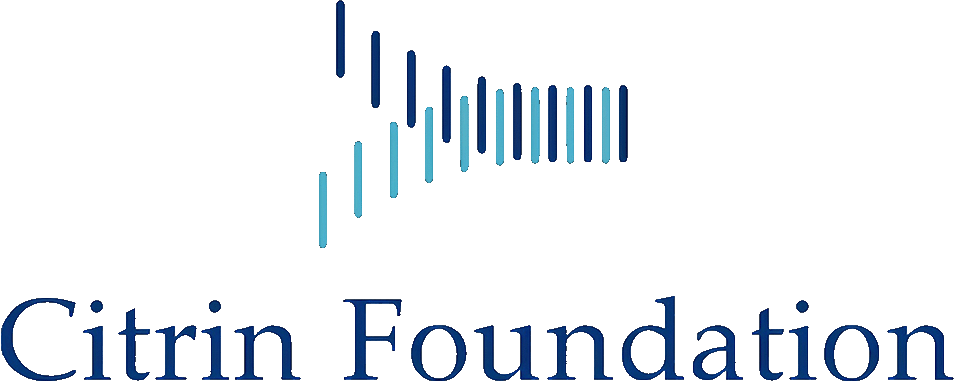The following peer-reviewed publications resulted from research projects funded wholly or partially by grants provided by the Citrin Foundation.
2024
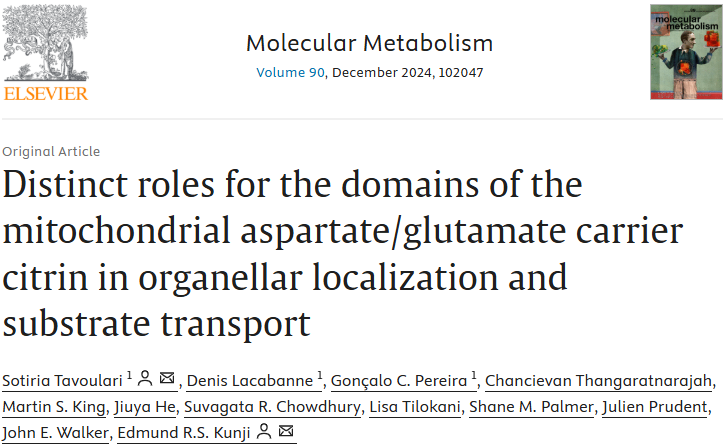
Abstract
Objective
Citrin, the mitochondrial aspartate/glutamate carrier isoform 2 (AGC2), is structurally and mechanistically the most complex SLC25 family member, because it consists of three domains and forms a homo-dimer. Each protomer has an N-terminal calcium-binding domain with EF-hands, followed by a substrate-transporting carrier domain and a C-terminal domain with an amphipathic helix. The absence or dysfunction of citrin leads to citrin deficiency, a highly prevalent pan-ethnic mitochondrial disease. Here, we aim to understand the role of different citrin domains and how they contribute to pathogenic mechanisms in citrin deficiency.
Methods
We have employed structural modeling and functional reconstitution of purified proteins in proteoliposomes to assess the transport activity and calcium regulation of wild-type citrin and pathogenic variants associated with citrin deficiency. We have also developed a double knockout of citrin and aralar (AGC1), the two paralogs of the mitochondrial aspartate/glutamate carrier, in HAP1 cells to perform mitochondrial imaging and to investigate mitochondrial localisation.
Results
Using 33 pathogenic variants of citrin we clarify determinants of subcellular localization and transport mechanism. We identify crucial elements of the carrier domain that are required for transport, including those involved in substrate binding, network formation and dynamics. We show that the N-terminal domain is not involved in calcium regulation of transport, as previously thought, but when mutated causes a mitochondrial import defect.
Conclusion
Our work introduces a new role for the N-terminal domain of citrin and demonstrates that dysfunction of the different domains contributes to distinct pathogenic mechanisms in citrin deficiency.
Read more details about the article here.

Abstract
Citrin deficiency (CD) is a recessive, liver disease caused by sequence variants in the SLC25A13 gene encoding a mitochondrial aspartate–glutamate transporter. CD manifests as different age-dependent phenotypes and affects crucial hepatic metabolic pathways including malate–aspartate-shuttle, glycolysis, gluconeogenesis, de novo lipogenesis and the tricarboxylic acid and urea cycles. Although the exact pathophysiology of CD remains unclear, impaired use of glucose and fatty acids as energy sources due to NADH shuttle defects and PPARα downregulation, respectively, indicates evident energy deficit in CD hepatocytes. The present review summarizes current trends on available and potential treatments for CD.
Baseline recommendation for CD patients is dietary management, often already present as a self-selected food preference, that includes protein and fat-rich food, and avoidance of excess carbohydrates. At present, liver transplantation remains the sole curative option for severe CD cases. Our extensive literature review indicated medium-chain triglycerides (MCT) as the most widely used CD treatment in all age groups. MCT can effectively improve symptoms across disease phenotypes by rapidly supplying energy to the liver, restoring redox balance and inducing lipogenesis. In contrast, sodium pyruvate restored glycolysis and displayed initial preclinical promise, with however limited efficacy in adult CD patients. Ursodeoxycholic acid, nitrogen scavengers and L-arginine treatments effectively address specific pathophysiological aspects such as cholestasis and hyperammonemia and are commonly administered in combination with other drugs. Finally, future possibilities including restoring redox balance, amino acid supplementation, enhancing bioenergetics, improving ureagenesis and mRNA/DNA-based gene therapy are also discussed.
Read more details about the article here.
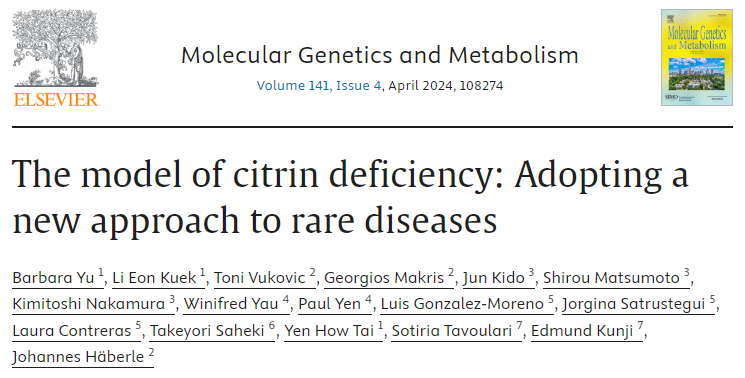
Background
Citrin deficiency (CD) is a rare metabolic condition due to mutations in the SLC25A13 gene encoding citrin. Citrin is the mitochondrial aspartate-glutamate carrier, a component of the malate-aspartate shuttle, involved in moving reducing equivalents (NADH) from the cytosol into the mitochondria and for supplying aspartate to the cytosol. CD is a complex disorder with diverse phenotypes. It primarily affects the liver with several major pathways including glycolysis, gluconeogenesis, lipid metabolism, the TCA cycle and ureagenesis being impacted.
Based on published carrier rates in several East Asian ethnicities and considering their respective populations, the expected number of CD patients in the United States would be approximately 2,000. However, there are currently <50 cd patients in the us known to scientific community.
To close this dramatic gap in diagnosis, Citrin Foundation, a non-profit, research-driven, patient-centric organization dedicated to finding a cure for CD, proposes a new long-term, holistic, innovative, global and multidisciplinary approach to tackle rare diseases, using CD as a model disease.
Read more details about the article here.
Abstract
Citrin deficiency is an autosomal recessive disorder caused by a defect of citrin resulting from mutations in SLC25A13. The clinical manifestation is very variable and comprises three types: neonatal intrahepatic cholestasis caused by citrin deficiency (NICCD: OMIM 605814), post-NICCD including failure to thrive and dyslipidemia caused by citrin deficiency, and adult-onset type II citrullinemia (CTLN2: OMIM 603471). Frequently, NICCD can run with a mild clinical course and manifestations may resolve in the post-NICCD. However, a subset of patients may develop CTLN2 when they become more than 18 years old, and this condition is potentially life-threatening. Since a combination of diet with low-carbohydrate and high-fat content supplemented with medium-chain triglycerides is expected to ameliorate most manifestations and to prevent the progression to CTLN2, early detection and intervention are important and may improve long-term outcome in patients. Moreover, infusion of high sugar solution and/or glycerol may be life-threatening in patients with citrin deficiency, particularly CTLN2.
The disease is highly prevalent in East Asian countries but is more and more recognized as a global entity. Since newborn screening for citrin deficiency has only been introduced in a few countries, the diagnosis still mainly relies on clinical suspicion followed by genetic testing or selective metabolic screening. This paper aims at describing (1) the different stages of the disease focusing on clinical aspects; (2) the current published clinical situation in East Asia, Europe, and North America; (3) current efforts in increasing awareness by establishing management guidelines and patient registries, hereby illustrating the ongoing development of a global network for this rare disease.
Read more details about the article here.
2023

Abstract
Citrin deficiency is an autosomal recessive disorder caused by a defect of citrin resulting from mutations in the SLC25A13 gene. Intrahepatic cholestasis and various metabolic abnormalities, including hypoglycemia, galactosemia, citrullinemia, and hyperammonemia may be present in neonates or infants in the “neonatal intrahepatic cholestasis caused by citrin deficiency” (NICCD) form of the disease.
Because at present, newborn screening (NBS) for citrin deficiency using citrulline levels in dried blood spots (DBS) can only detect some of the patients, we tried to develop a new evaluation system to more reliably detect newborns with citrin deficiency utilizing parameters already in place in present NBS methods. To achieve this goal, we re-analyzed NBS profiles of amino acids and acylcarnitines in 96 NICCD patients, who were diagnosed through selective screening or positive family history.Hereby, we identified the combined evaluation of arginine (Arg), citrulline (Cit), isoleucine+leucine (Ile + Leu), tyrosine (Tyr), free carnitine (C0) / glutarylcarnitine (C5-DC) ratio in DBS as potentially sensitive to diagnose citrin deficiency in pre-symptomatic newborns. In particular, a scoring system using threshold levels for Arg (≥9 μmol/L), Cit (≥ 39 μmol/L), Ile + Leu (≥ 99 μmol/L), Tyr (≥ 96 μmol/L) and C0/C5-DC ratio (≥327) was significantly effective to detect newborns who later developed NICCD, and could thus be implemented in existing NBS programs at no extra analytical costs whenever citrin deficiency is considered to become a novel target disease.
Read more details about the article here.
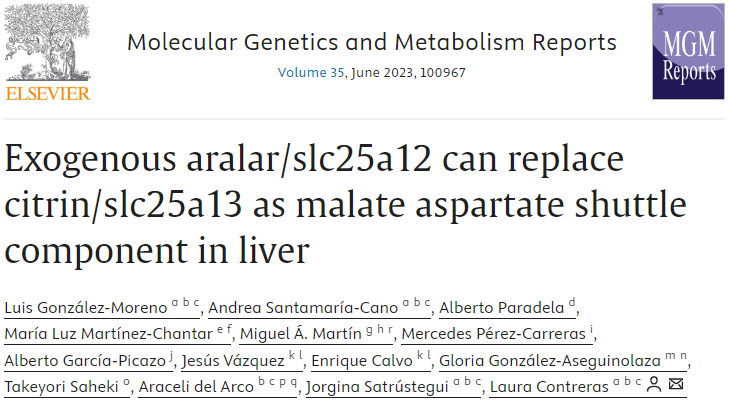
Abstract
The deficiency of CITRIN, the liver mitochondrial aspartate–glutamate carrier (AGC), is the cause of four human clinical phenotypes, neonatal intrahepatic cholestasis caused by CITRIN deficiency (NICCD), silent period, failure to thrive and dyslipidemia caused by CITRIN deficiency (FTTDCD), and citrullinemia type II (CTLN2). Clinical symptoms can be traced back to disruption of the malate-aspartate shuttle due to the lack of citrin. A potential therapy for this condition is the expression of aralar, the AGC present in brain, to replace citrin. To explore this possibility we have first verified that the NADH/NAD+ ratio increases in hepatocytes from citrin(−/−) mice, and then found that exogenous aralar expression reversed the increase in NADH/NAD+ observed in these cells. Liver mitochondria from citrin (−/−) mice expressing liver specific transgenic aralar had a small (~ 4–6 nmoles x mg prot−1 x min−1) but consistent increase in malate aspartate shuttle (MAS) activity over that of citrin(−/−) mice.
These results support the functional replacement between AGCs in the liver. To explore the significance of AGC replacement in human therapy we studied the relative levels of citrin and aralar in mouse and human liver through absolute quantification proteomics. We report that mouse liver has relatively high aralar levels (citrin/aralar molar ratio of 7.8), whereas human liver is virtually devoid of aralar (CITRIN/ARALAR ratio of 397). This large difference in endogenous aralar levels partly explains the high residual MAS activity in liver of citrin(−/−) mice and why they fail to recapitulate the human disease, but supports the benefit of increasing aralar expression to improve the redox balance capacity of human liver, as an effective therapy for CITRIN deficiency.
Read more details about the article here.
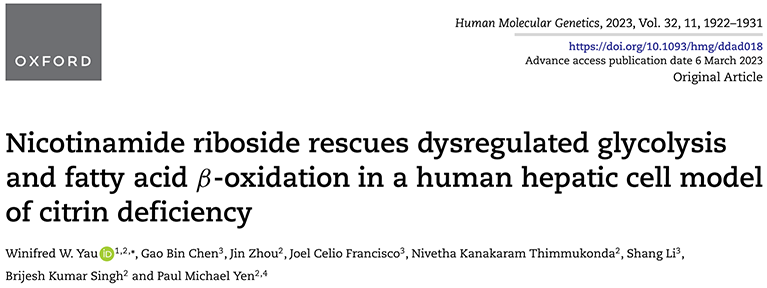
Abstract
Citrin deficiency (CD) is an inborn error of metabolism caused by loss-of-function of the mitochondrial aspartate/glutamate transporter, CITRIN, which is involved in both the urea cycle and malate–aspartate shuttle. Patients with CD develop hepatosteatosis and hyperammonemia but there is no effective therapy for CD. Currently, there are no animal models that faithfully recapitulate the human CD phenotype. Accordingly, we generated a CITRIN knockout HepG2 cell line using Clustered Regularly Interspaced Short Palindromic Repeats/Cas 9 genome editing technology to study metabolic and cell signaling defects in CD.
CITRIN KO cells showed increased ammonia accumulation, higher cytosolic ratio of reduced versus oxidized form of nicotinamide adenine dinucleotide (NAD) and reduced glycolysis. Surprisingly, these cells showed impaired fatty acid metabolism and mitochondrial activity. CITRIN KO cells also displayed increased cholesterol and bile acid metabolism resembling those observed in CD patients. Remarkably, normalizing cytosolic NADH:NAD+ ratio by nicotinamide riboside increased glycolysis and fatty acid oxidation but had no effect on the hyperammonemia suggesting the urea cycle defect was independent of the aspartate/malate shuttle defect of CD. The correction of glycolysis and fatty acid metabolism defects in CITRIN KO cells by reducing cytoplasmic NADH:NAD+ levels suggests this may be a novel strategy to treat some of the metabolic defects of CD and other mitochondrial diseases.
Read more details about the article here.
2022

Abstract
Citrin deficiency is a pan-ethnic and highly prevalent mitochondrial disease with three different stages: neonatal intrahepatic cholestasis (NICCD), a relatively mild adaptation stage, and type II citrullinemia in adulthood (CTLN2). The cause is the absence or dysfunction of the calcium-regulated mitochondrial aspartate/glutamate carrier 2 (AGC2/SLC25A13), also called citrin, which imports glutamate into the mitochondrial matrix and exports aspartate to the cytosol. In citrin deficiency, these missing transport steps lead to impairment of the malate-aspartate shuttle, gluconeogenesis, amino acid homeostasis, and the urea cycle. In this review, we describe the geological spread and occurrence of citrin deficiency, the metabolic consequences and use our current knowledge of the structure to predict the impact of the known pathogenic mutations on the calcium-regulatory and transport mechanism of citrin.
Read more details about the article here.
2021

Abstract
Citrin deficiency is characterized by a wide range of symptoms from infancy through adulthood and presents a distinct preference for a diet composed of high protein, high fat, and low carbohydrate. The present study elucidates the important criteria by patients with citrin deficiency for food selection through detailed analysis of their food preferences. The survey was conducted in 70 citrin-deficient patients aged 2–63 years and 55 control subjects aged 2–74 years and inquired about their preference for 435 food items using a scale of 1–4 (the higher, the more favored).
The results showed that the foods marked as “dislike” accounted for 36.5% in the patient group, significantly higher than the 16.0% in the controls. The results also showed that patients clearly disliked foods with 20–24 (% of energy) or less protein, 45–54% (of energy) or less fat, and 30–39% (of energy) or more carbohydrate. Multiple regression analysis showed carbohydrates had the strongest influence on patients’ food preference (β = −0.503). It also showed female patients had a stronger aversion to foods with high carbohydrates than males. The protein, fat, and carbohydrate energy ratio (PFC) of highly favored foods among patients was almost the same as the average PFC ratio of their daily diet (protein 20–22: fat 47–51: carbohydrates 28–32). The data strongly suggest that from early infancy, patients start aspiring to a nutritional balance that can compensate for the metabolism dissonance caused by citrin deficiency in every food.
Read more details about the article here.
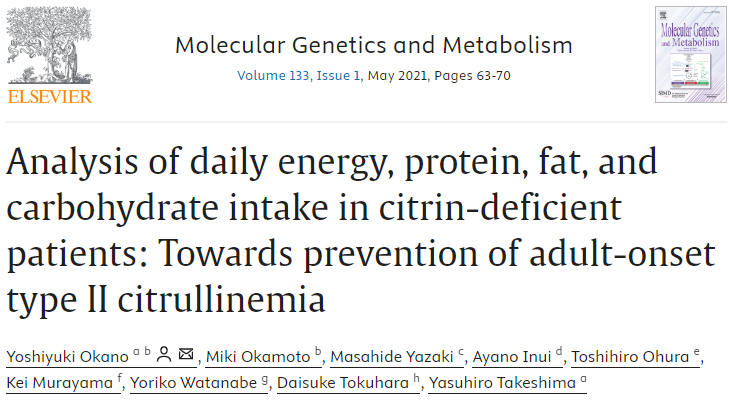
Abstract
Patients with citrin deficiency during the adaptation/compensation period exhibit diverse clinical features and have characteristic diet of high protein, high fat, and low carbohydrate. Japanese cuisine typically contains high carbohydrate but evaluation of diet of citrin-deficient patients in 2008 showed a low energy intake and a protein:fat:carbohydrate (PFC) ratio of 19:44:37, which indicates low carbohydrate consumption rate. These findings prompted the need for diet intervention to prevent the adult onset of type II citrullinemia (CTLN2). Since the publication of the report about 10 years ago, patients are generally advised to eat what they wish under active dietary consultation and intervention. In this study, citrin-deficient patients and control subjects living in the same household provided answers to a questionnaire, filled-up a maximum 6-day food diary, and supplied physical data and information on medications if any. To study the effects of the current diet, the survey collected data from 62 patients and 45 controls comparing daily intakes of energy, protein, fat, and carbohydrate.
Food analysis showed that patient's energy intake was 115% compared to the Japanese standard. The confidence interval of the PFC ratio of patients was 20–22:47–51:28–32, indicating higher protein, higher fat and lower carbohydrate relative to previous reports. The mean PFC ratio of female patients (22:53:25) was significantly different from that of male patients (20:46:34), which may explain the lower frequency of CTLN2 in females. Comparison of the present data to those published 10 years ago, energy, protein, and fat intakes were significantly higher but the amount of carbohydrate consumption remained the same. Regardless of age, most patients (except for adolescents) consumed 100–200 g/day of carbohydrates, which met the estimated average requirement of 100 g/day for healthy individuals. Finally, patients were generally not overweight and some CTLN2 patients were underweight although their energy intake was higher compared with the control subjects. We speculate that high-energy of a low carbohydrate diet under dietary intervention may help citrin-deficient patients attain normal growth and prevent the onset of CTLN2.
Read more details about the article here.
2020

Abstract
Can you imagine a disease in which intake of an excess amount of sugars or carbohydrates causes hyperammonemia? It is hard to imagine the intake causing hyperammonemia. AGC2 or citrin deficiency shows their symptoms following sugar/carbohydrates intake excess and this disease is now known as a pan-ethnic disease. AGC2 (aspartate glutamate carrier 2) or citrin is a mitochondrial transporter which transports aspartate (Asp) from mitochondria to cytosol in exchange with glutamate (Glu) and H+. Asp is originally supplied from mitochondria to cytosol where it is necessary for synthesis of proteins, nucleotides, and urea.
In cytosol, Asp can be synthesized from oxaloacetate and Glu by cytosolic Asp aminotransferase, but oxaloacetate formation is limited by the amount of NAD+. This means an increase in NADH causes suppression of Asp formation in the cytosol. Metabolism of carbohydrates and other substances which produce cytosolic NADH such as alcohol and glycerol suppress oxaloacetate formation. It is forced under citrin deficiency since citrin is a member of malate/Asp shuttle. In this review, we will describe history of identification of the SLC25A13 gene as the causative gene for adult-onset type II citrullinemia (CTLN2), a type of citrin deficiency, pathophysiology of citrin deficiency together with animal models and possible treatments for citrin deficiency newly developing.
Read more details about the article here.
2019
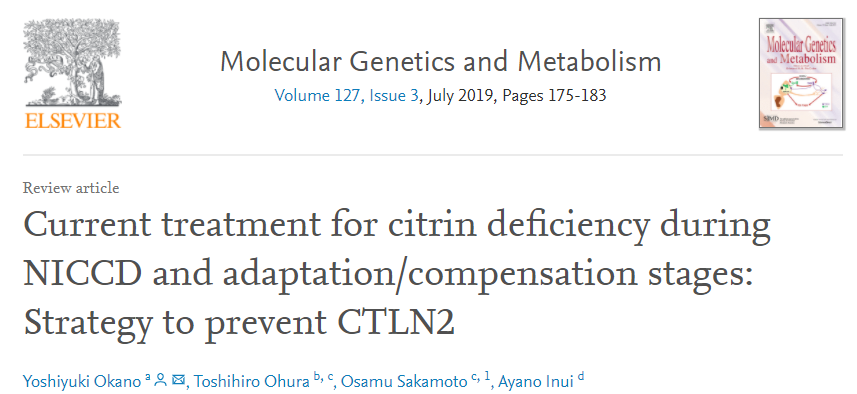
Abstract
Identification of the genes responsible for adult-onset type II citrullinemia (CTLN2) and citrin protein function have enhanced our understanding of citrin deficiency. Citrin deficiency is characterized by 1) neonatal intrahepatic cholestasis caused by citrin deficiency (NICCD); 2) adaptation/compensation stage with unique food preference from childhood to adulthood; and 3) CTLN2. The treatment of NICCD aims to prevent the progression of cholestasis, and it includes medium chain triglycerides (MCT) milk and lactose-free milk, in addition to medications (e.g., vitamin K2, lipid-soluble vitamins and ursodeoxycholic acid). Spontaneous remission around the age of one is common in NICCD, though prolonged cholestasis can lead to irreversible liver failure and may require liver transplantation. The adaptation/compensation stage (after one year of age) is characterized by the various signs and symptoms such as hypoglycemia, fatty liver, easy fatigability, weight loss, and neuropsychiatric symptoms. Some poorly-controlled patients show failure to thrive and dyslipidemia caused by citrin deficiency (FTTDCD).
Diet therapy is the key in the adaptation/compensation stage. Protein- and fat-rich diet with a protein: fat: carbohydrate ratio being 15–25%: 40–50%: 30–40% along with the appropriate energy intake is recommended. The use of MCT oil and sodium pyruvate is also effective. The toxicity of carbohydrate is well known in the progression to CTLN2 if the consumption is over a long term or intense. Alcohol can also trigger CTLN2. Continuous intravenous hyperalimentation with high glucose concentration needs to be avoided. Administration of Glyceol® (an osmotic agent containing glycerol and fructose) is contraindicated. Because the intense treatment such as liver transplantation may become necessary to cure CTLN2, the effective preventative treatment during the adaptation/compensation stage is very important. At present, there is no report of a case with patients reported having the onset of CTLN2 who are on the diet therapy and under the appropriate medical support during the adaptation/compensation stage.
Read more details about the article here.

Abstract
Previous studies using citrin/mitochondrial glycerol-3-phosphate (G3P) dehydrogenase (mGPD) double-knockout mice have demonstrated that increased dietary protein reduces the extent of carbohydrate-induced hyperammonemia observed in these mice. This study aimed to further elucidate the mechanisms of this effect. Specific amino acids were initially found to decrease hepatic G3P, or increase aspartate or citrulline levels, in mGPD-knockout mice administered ethanol. Unexpectedly, oral glycine increased ammonia in addition to lowering G3P and increasing citrulline. Subsequently, simultaneous glycine-plus-sucrose (Gly + Suc) administration led to a more severe hyperammonemic state in double-KO mice compared to sucrose alone.
Oral arginine, ornithine, aspartate, alanine, glutamate and medium-chain triglycerides all lowered blood ammonia following Gly + Suc administration, with combinations of ornithine-plus-aspartate (Orn + Asp) or ornithine-plus-alanine (Orn + Ala) suppressing levels similar to wild-type. Liver perfusion and portal vein-arterial amino acid differences suggest that oral aspartate, similar to alanine, likely activated ureagenesis from ammonia and lowered the cytosolic NADH/NAD+ ratio through conversion to alanine in the small intestine. In conclusion, Gly + Suc administration induces a more severe hyperammonemic state in double-KO mice that Orn + Asp or Orn + Ala both effectively suppress. Aspartate-to-alanine conversion in the small intestine allows for effective oral administration of either, demonstrating a pivotal role of inter-organ aspartate metabolism for the treatment of citrin deficiency.
Read more details about the article here.



